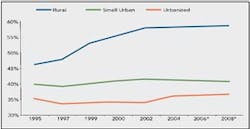Independent Shops: Uneven Wear Pattern
The U.S. Department of Transportation (DOT) Federal Highway Administration (FHWA) reports the quality of the nation’s roads in the annual system evaluation, National Transportation Statistics. The report contains information on the extent of the U.S. road system, vital characteristics such as lane width and bridge integrity, and—the subject of this report—road surface quality.
The evaluation of road quality is based on the International Roughness Index (IRI) or Present Serviceability Rating (PSR). To remain consistent with both the adopted practices of the FHWA and previous editions of Market Analysis, will we use only IRI measures in this report.
The IRI has three categories used by the FHWA: good, acceptable and not acceptable. The reports are based on data from 1995 to 2004. Rural road quality has shown consistent improvement, yet the surfaces of roads in large urban areas have deteriorated during the same period when judged on the standard of acceptable versus unacceptable. Urban roads are separated into two categories—small urban and urbanized—and the urbanized category is posting the decline while the small urban (similar to suburban) has remained flat.
When shifting the standard from acceptable to good, the percentages by area all drop dramatically. Rural mileage was on roads rated acceptable 94.5 percent of the time in 2004, yet only 58.3 percent were rated good. The decline is even more dramatic for urban areas when shifting from acceptable to good.
The small urban category falls from 84.3 percent to 41.2, while urbanized zones drop from 79.2 percent to 36.1 percent.
Yet the evaluation to the good standard is not all bad news. Contrary to the trend seen in meeting the acceptable standards, road travel in urbanized areas has risen steadily for nearly a decade. Similar to the trends in acceptable ride quality mileage, rural vehicle travel road quality reaching the good standard has shown strong gains and small urban travel has been mostly flat.
To compliment the FHWA data, TRIP, a non-profit transportation research group, published the report, “Keep Both Hands on the Wheel: Metro Areas with the Roughest Rides and Strategies to Make our Roads Smoother,” in March 2008. The TRIP report claims “the average urban motorist in the United States is paying $413 annually in additional vehicle operating costs” because of rough road conditions.
The report also details the worst urban areas in the nation. Typically one associates bad roads with the northern areas that endure frequent freeze-thaw cycles capable of cracking surfaces so easily. However, the TRIP report’s top urban areas show a different distribution of the poorest road quality—Los Angeles, San Francisco-Oakland, Honolulu, San Jose and San Diego are the five worst urban areas.
The gravity of the problem is also far greater in these areas than others. Los Angeles, site of the worst roads, has 65 percent of roads in substandard condition. By comparison, Washington, D.C.—20th on the list and often thought to be home to some of the worst roads in the country—comes in at 30 percent not acceptable. New York, Philadelphia, Baltimore and Oklahoma City were just beyond the top five; locations where harsh winters certainly contribute to pavement degradation.
However, the location of the cities with the worst roads underscores the need for proper design, construction and maintenance in order to keep the vital transportation system of the nation in proper operating condition. As prices for commodities continue to increase, road maintenance may suffer under the weight of surging costs. Yet, TRIP reports that proper maintenance of roads can reduce total lifecycle costs by 25 percent.
